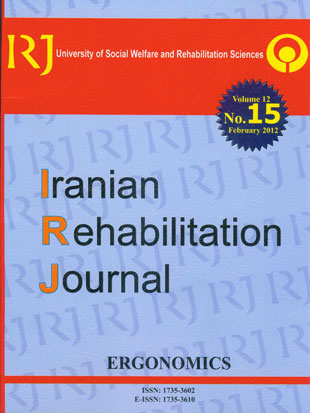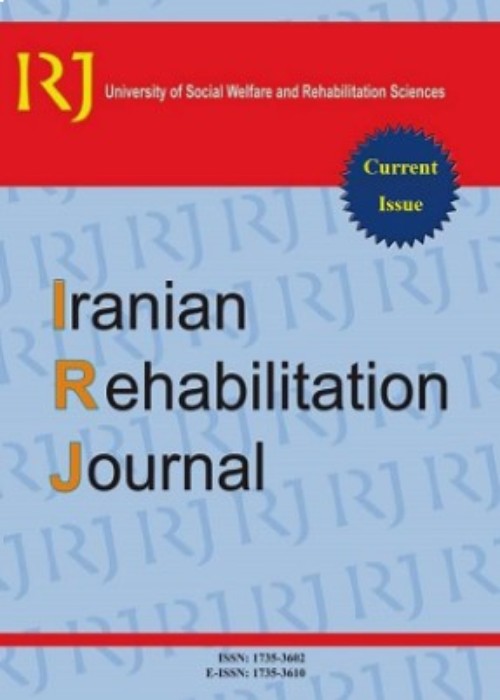فهرست مطالب

Iranian Rehabilitation Journal
Volume:10 Issue: 15, Feb 2012
- Special Issue- Ergonomics
- تاریخ انتشار: 1391/01/09
- تعداد عناوین: 8
-
-
Page 3ObjectivesAlthough for those spinal cord injury (SCI) patients with paralysis of the legs but not at arms, the primary means of mobility post injury is the manual wheelchair, there are many physiological and psychological advantages to standing and walking, such as improvement in respiratory function, lower limb weight bearing and preventing osteoporosis, pressure sores prevention etc. High metabolic energy expenditure of orthotic ambulation in contrast with the manual wheelchair is the most limitation of the orthotic gait currency for SCI patients.MethodsIn the present study, the effect of the spatial and temporal parameters on the mechanical energy expenditure of the paraplegic locomotion was investigated in search for a modified gait pattern which provides lower energy Expenditure. A 3D four segment 6-DOF model of the paraplegic locomotion was developed based on the data acquired from an experimental study on a single spine cord injury subject. A Response Surface Methodology (RSM) was then performed to determine the impact of the kinematical parameters on the resulting the joint torques.ResultsAccording to the RSM analysis, the whole body forward inclination around the stance leg has been recognized as the most effective kinematics parameter on the total muscular effort as an index of energy expenditure during the paraplegic gait.ConclusionIt was concluded that with a reduction on the step length accompanied with cadence increasing in a modified gait pattern, the paraplegic individuals are expected to achieve improved energy expenditure.
-
Page 15ObjectivesThis study aimed to evaluate and analyze the ergonomic behaviors order to select the best work shift group in an Iranian petrochemical Company, in 2010.MethodsThe methodology was based on the Ergonomic Behavior Sampling (EBS), and performed using ELECTRE method. In this study 1147 behaviors were observed.ResultsThe results indicated that 43.6% of workers’ behaviors were unergonomic. The most frequent unergonomic behavior was amusing of legs while load lifting with 83.01% of total unergonomic behaviors observations. Using ELECTRE method, most effective shift group and least attractive alternatives for intervention were selected in the company.DiscussionFindings declare high number of unergonomic behaviors. Catastrophic consequences of accidents in petrochemical industry necessitate paying more attention to workers’ ergonomic behaviors in the workplace.
-
Page 21IntroductionBehavioral-based safety is a term used to describe the prevention of accidents, injuries and loss in the workplace. An effective behavior-based safety program relies on engaging employees to understand how unsafe behaviors lead to injuries and how to eliminate them from the workplace. This paper examines behavior-based safety program in a massive construction site.MethodFor this purpose experiment and control groups were selected and performance feedback of workers about unsafe and critical behaviors has been reviewed.ResultTest results show that among the critical behaviors, using ladder correctly among the workers had good feedback, but there is still a problem in concrete pouring behavior. Safety performance index of the experimental group has changed from 66% to 92%.DiscussionBehavioral-based safety, an approach of identifying and preventing accidents, has many advantages. Implementing behavioral-based safety practices in the workplace ensures a protected environment. Observations identify which behaviors may be unsafe; therefore the best practices may be developed.
-
Page 26ObjectivesAn effective safety management requires paying attention to human factors. One of the most important methods for achievement to accident prevention is using safety climate or safety culture. Moreover, some studies suggest that in most organizations behavior contributes to 86-96% of all injuries. This cross-sectional study was performed on the functional units’ workers of Khuzestan Petrochemical Company, in 2010.MethodsData collection tools were safety climate questionnaire that has been presented by Kumar et al. (2009), Ergonomic Behavior Sampling and collected data was analyzed by SPSS 16.ResultsWith reference to the results of a pilot study, a sample of 1147 was determined for Behavior Sampling. The numbers of returned valid questionnaires were 134 out of 151 and response rate was %88.74. Questionnaire reliability assessed by Cronbach’s Alpha, was 0.928. Results indicated, management commitment and actions for safety, workers’ knowledge and compliance to safety, and workers’ attitudes towards safety, are those safety climate factors which have obtained the highest correlation coefficient with ergonomic behaviors and as predictors on multi-variants linear regression model for ergonomic behavior forecasting.DiscussionResults showed the importance of decreasing number of workers with negative safety climate. Also, results obligate paying attention to workers’ ergonomic behaviors in the workplace and their promotion.
-
Page 31ObjectivesMost studies have performed to identify the affective variables in using mobile phone by drivers based on interview and questionnaire. In this study call answering rate while driving was investigated in a sample of male postgraduate students of a university in Tehran by a driving simulator.MethodSix driving scenario designed differing in risk of driving. Answer rate to mobile phone calls during observation of driving scenarios were recorded.ResultsLogistic regression models revealed that participants perceived two-way roads and high speeds more risky than one-way roads and low speeds. Also, results indicated that decision to answer to calls while driving is ruled by personality trait than difficulty of driving scenario or age.Conclusiondrivers in all ages and experiences and different driving scenarios may decide to start answering mobile phone while driving. Traffic safety campaigns against using mobile phones on roads should be focused on personality trait of drivers.
-
Page 37ObjectivesOne of the applications of ergonomics disciplinary is designing driver workstation compatible to users’ characteristics. The aim of this study was evaluation of interior design of Shoka vehicle with respect to the accommodation for Iranian population and proposing suggestions for customizing design of the vehicle.MethodThis study was a descriptive-analytical study conducted among thirty men from Iranian drivers population in 5, 50, 95 percentiles of the stature variable. Objective variables related to the occupant packaging and vehicle visual aspects including anthropometric variables, frontal, lateral, and side view and so on were investigated first. Then, subjective variables related to the driver mental workload and body comfort discomfort were studied using BMDMW and comfort questionnaires during 2-hour driving trial sessions.ResultsOccupant packaging variables and hand-arm angle showed the least accommodation percent (%53). Seating angles showed low accommodation as well (%73). Among three percentile groups there were no significant differences between the mean values of mental workload during two hours driving task. The mean value related to the comfort discomfort was 3.9 during driving sessions.ConclusionConsidering the findings in this study, it can be concluded that seating angles need correction and optimization. Taking mental workload results into account, it can be concluded that the interior design of the studied car had no influence on drivers’ mental workload. From the aspect of comfort/discomfort, Shoka vehicle showed neutral state among drivers. Optimizing seating angles, decreasing vibration, correcting stiffness of seating pan are suggested for customization of the ergonomics aspect of this vehicle.
-
Page 43ObjectivesThe objective of this study is to evaluate the safety climate as an important part of macroergonomics domains and to determine the importance of each safety climate factor in an Iranian company.MethodsFor data gathering, the researchers used Macroergonomic Organizational Questionnaire Survey (MOQS) method. For conducting this method we applied safety climate questionnaire which has been presented by Vinodkumar et al. After distribution of questionnaires through our samples with accuracy of 5% and confidence level of 95% and gathering the questionnaires, data were analyzed using SPSS V.16 software and Entropy.ResultsThe number of returned valid questionnaires was 134 out of 151 and response rate was 88.74%. Questionnaire’s reliability which assessed by Cronbach’s Alpha was 0.928. The results indicated that mean of safety climate score was 154/84; and 68.7% of workers had positive safety attitudes. In addition, we found a significant relationship between ages on safety climate (P< 0.05). The highest and lowest weights, which are obtained by entropy, belong to safeness of work environment and emergency preparedness in the organization with weights of 0.197 and 0.144 respectively.DiscussionConsidering catastrophic consequences of accidents in petrochemical industry, the results show the importance of attention to safety principles and to develop a positive employee attitudes related to safety.
-
Page 47ObjectivesBecause of the high rates of accidents, the construction industry has become a hazardous industry in Iran and therefore paying more attention is required. This paper investigates safety management in construction companies for improving workers’ safety as one of the ergonomics aims.MethodsIn order to survey the safety management in construction companies a questionnaire was prepared and all aspects in construction safety management structure were included.ResultsThe main important problems of safety management in construction include: lack of safety training, lack of provision of personal protection equipment, absence of safety and health specialized staff in construction sites, disuse of safety regulations and lack of updated rules, traditional management attitudes toward safety as a cost.DiscussionDespite other industries, safety, health, and environment management have not found its true position in the construction sector; however some construction companies have established some provisional measures recently. Among the most important problems in safety management in the construction sector, these items can be mentioned: regulations need to be reviewed considering the type of project, low cultural level of the working class, and safety leadership do not perform well in the construction sites.


